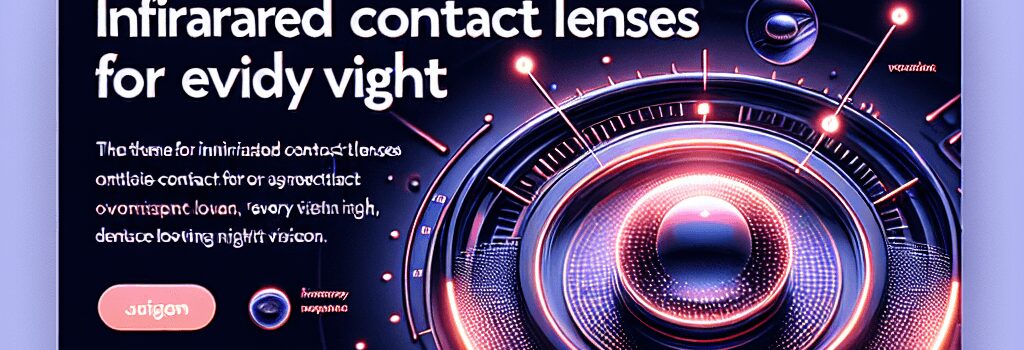Infrared Contact Lenses for Everyday Night Vision

Researchers have taken a major step toward equipping both mice and humans with the ability to detect infrared (IR) light—even through closed eyelids—using specially engineered contact lenses. While the current prototypes deliver only limited resolution, they open the door to wearable night-vision devices that are compact, biocompatible, and unobtrusive.
Technical Background: How Infrared Detection Works
Traditional night-vision systems rely on bulky optics or cryogenically cooled sensors. In contrast, the new contact lenses integrate photon upconversion layers onto soft hydrogel substrates:
- Upconversion nanoparticles: Rare‐earth-doped sodium yttrium fluoride (NaYF4) particles that absorb infrared photons (wavelengths 800–1,100 nm) and emit visible-red light (~620 nm).
- Transparent electrodes: Ultrathin, flexible indium tin oxide (ITO) films patterned to minimize optical distortion while delivering power to embedded active layers.
- Hydrogel matrix: Biocompatible, tear-permeable polymer capable of sustaining ocular surface health over extended wear times.
Experimental Setup and Performance
- In vivo validation: Mice were fitted with prototype lenses and exposed to controlled IR sources; neuronal responses in the visual cortex were recorded via multi‐electrode arrays.
- Human trials: Volunteers wore the lenses in a dark chamber and identified simple shapes projected with IR illumination (1 mW/cm²). Participants reported perceiving silhouettes despite closed eyelids.
- Resolution limits: Current spatial resolution is estimated at ~0.1 cycles per degree—sufficient to discern basic forms but far below normal human vision (~30 cpd).
Mechanism of Photon Upconversion
“By harnessing rare-earth dopants, we can convert invisible IR photons into wavelengths the retina recognizes,” says Dr. Elena Martin, lead author of the study. “This approach bypasses the need for external power supplies or bulky relay optics.” — Dr. Elena Martin, Optoelectronics Director, University Research Lab
Applications and Potential Use Cases
- Military and law enforcement: Covert night-vision without external goggles.
- Search & rescue: First responders could navigate in darkness while maintaining full peripheral awareness.
- Wildlife research: Noninvasive observation of nocturnal species without disturbing natural behavior.
- Medical diagnostics: Infrared imaging of tissue perfusion at cellular scales, directly visualized by clinicians.
Safety and Biocompatibility Considerations
Ensuring ocular safety is paramount. To date, lenses have passed ISO 10993 cytotoxicity tests and demonstrate:
- ≥95% cell viability in corneal epithelial assays.
- Stable tear‐film compatibility over 8-hour wear cycles.
- No detectable heat generation at IR intensities up to 2 mW/cm².
Commercialization Prospects
Several startups are in talks with defense agencies and medical-device firms. Manufacturing is projected to leverage roll‐to‐roll nanofabrication, targeting unit costs below $50 for volume production by 2026. Key challenges include scaling uniform nanoparticle deposition and integrating wireless power reception.
Ethical and Privacy Considerations
Equipping civilians with night-vision raises regulatory questions. Privacy advocates urge clear usage guidelines to prevent unauthorized surveillance. Technical safeguards, such as time-limited activation and encrypted beamforming, are under discussion.
Future Directions
Next-generation prototypes aim to:
- Enhance resolution to ~1 cpd via optimized nanoparticle geometry.
- Broaden spectral sensitivity into the shortwave infrared (SWIR) band (1,400–1,600 nm).
- Incorporate on-lens microbatteries or energy harvesting for active modulation.
If successful, these advances could transform wearable augmented-vision, making night-vision as ubiquitous as corrective lenses.
Hi,
I just visited webcraftingcode.com and wondered if you’d ever thought about having an engaging video to explain what you do?
Our videos cost just $195 for a 30 second video ($239 for 60 seconds) and include a full script, voice-over and video.
I can show you some previous videos we’ve done if you want me to send some over. Let me know if you’re interested in seeing samples of our previous work.
Regards,
Joanna
Hi, I represent a social media marketing agency that creates 15 engaging posts per month for businesses like yours. Our clients typically see a 40-60% increase in followers and engagement for just $199/month. Would you be interested?”